Combustion and Emission Characteristics According to the Fuel Injection Ratio of an Ultra-Lean LPG Direct Injection Engine
Abstract
:1. Introduction
2. Experimental Procedures
2.1. Experimental Setup
2.2. Experimental Methods
3. Results
3.1. Effect of SA on Efficiency and Combustion Stability
3.2. Effect of First Fuel Injection Timing on Efficiency and Combustion Stability
3.3. Effect of Fuel Injection Ratio on Efficiency and Combustion Stability
3.4. Effect of Fuel Injection Ratio on Engine Emissions
4. Conclusions
- (1)
- Although the combustion stability is secured through first fuel injection and spark discharge earlier than 29 and 27 CAD BTDC, respectively, at 50%/50% fuel injection ratio, the heat release does not efficiently translate to combustion power gains when the piston is moving upward to TDC.
- (2)
- The flame initiation, which can affect the combustion stability, is insensitive to the first fuel injection timing with advanced fuel injection and fixed SA timing condition because the ignitable mixture always exists within the local recirculation zone proximal to the spark plug.
- (3)
- The combustion stability is improved because of the locally rich mixture region in the recirculation zone with an increase in the proportion of the first fuel injected at a ratio of 60%/40%. The interval between the fuel injection and SA timing should be optimized because the time needed for entrained air to form a stratified mixture varies with the operating conditions and fuel injection ratio.
- (4)
- With a 70%/30% fuel injection ratio, the advanced combustion phase and faster heat release rate from the richer stratified mixture of the first fuel injection results in an overall deterioration of thermal efficiency.
- (5)
- The NOx emissions with a 60%/40% fuel injection ratio are the highest because of the highest combustion temperature. The THC and CO emissions for 50%/50% and 60%/40% are similar, whereas those for 70%/30% are significantly higher because of fuel wetting and the formation of an overly lean mixture.
Acknowledgments
Author Contributions
Conflicts of Interest
References
- Jobson, E. Future challenges in automotive emission control. Top. Catal. 2004, 28, 191–199. [Google Scholar] [CrossRef]
- Lenzen, E. Macondo Publishing GmbH. Global Compact International Yearbook 2015; Macondo Publishing: Münster, Germany, 2015. [Google Scholar]
- Demirbas, A. Fuel properties of hydrogen, liquefied petroleum gas (LPG), and compressed natural gas (CNG) for transportation. Energy Sources 2002, 24, 601–610. [Google Scholar]
- Boretti, A.A.; Watson, H.C. Development of a direct injection high efficiency liquid phase LPG spark ignition engine. SAE Int. J. Engines 2009, 2, 1639–1649. [Google Scholar] [CrossRef]
- Kim, J.; Choi, K.; Myung, C.L.; Park, S. Experimental evaluation of engine control strategy on the time resolved THC and nano-particle emission characteristics of liquid phase LPG direct injection (LPG-DI) engine during the cold start. Fuel Process. Technol. 2013, 106, 166–173. [Google Scholar] [CrossRef]
- Park, C.; Park, Y.; Oh, S.; Lee, Y.; Kim, T.Y.; Kim, H.; Choi, Y.; Kang, K.Y. Emission Characteristics of Gasoline and LPG in a Spray-Guided-Type Direct Injection Engine; SAE Technical Paper 2013-01-1323; SAE International: Warrendale, PA, USA, 2013. [Google Scholar]
- Park, C.; Park, Y.; Oh, S.; Lee, Y.; Kim, T.Y. Effect of Injection Timing Retard on ISI Strategy in Lean-Burning LPG Direct Injection Engines; SAE Technical Paper 2013-01-2636; SAE International: Warrendale, PA, USA, 2013. [Google Scholar]
- Stone, R. Introduction to Internal Combustion Engines; Palgrave Macmillan: Basingstoke, UK, 2012. [Google Scholar]
- Heywood, J.B. Internal Combustion Engine Fundamentals; McGraw-Hill: New York, NY, USA, 1988. [Google Scholar]
- Harada, J.; Tomita, T.; Mizuno, H.; Mashiki, Z.; Ito, Y. Development of Direct Injection Gasoline Engine; SAE Technical Paper 970540; SAE International: Warrendale, PA, USA, 1997. [Google Scholar]
- Iwamoto, Y.; Noma, K.; Nakayama, O.; Yamauchi, T.; Ando, H. Development of Gasoline Direct Injection Engine; SAE Technical Paper 970541; SAE International: Warrendale, PA, USA, 1997. [Google Scholar]
- Kuwahara, K.; Ueda, K.; Ando, H. Mixing Control Strategy for Engine Performance Improvement in a Gasoline Direct Injection Engine; SAE Technical Paper 980158; SAE International: Warrendale, PA, USA, 1998. [Google Scholar]
- Noguchi, M.; Sanda, S.; Nakamura, N. Development of Toyota Lean Burn Engine; SAE Technical Paper 760757; SAE International: Warrendale, PA, USA, 1976. [Google Scholar]
- Schwarz, C.; Schünemann, E.; Durst, B.; Fischer, J.; Witt, A. Potentials of the Spray-Guided BMW DI Combustion System; SAE Technical Paper 2006-01-1265; SAE International: Warrendale, PA, USA, 2006. [Google Scholar]
- Chang, W.S.; Kim, Y.N.; Kong, J.K. Design and Development of a Spray-Guided Gasoline DI Engine; SAE Technical Paper 2007-01-3531; SAE International: Warrendale, PA, USA, 2007. [Google Scholar]
- Park, C.; Kim, S.; Kim, H.; Moriyoshi, Y. Stratified lean combustion characteristics of a spray-guided combustion system in a gasoline direct injection engine. Energy 2012, 41, 401–407. [Google Scholar] [CrossRef]
- Park, C.; Kim, S.; Kim, H.; Lee, S.; Kim, C.; Moriyoshi, Y. Effect of a split-injection strategy on the performance of stratified lean combustion for a gasoline direct-injection engine. Proc. Inst. Mech. Eng. Part D 2011, 225, 1415–1426. [Google Scholar] [CrossRef]
- Peterson, B.; Reuss, D.L.; Sick, V. On the ignition and flame development in a spray-guided direct-injection spark-ignition engine. Combust. Flame 2014, 161, 240–255. [Google Scholar] [CrossRef]
- Piock, W.F.; Weyand, P.; Wolf, E.; Heise, V. Ignition systems for spray-guided stratified combustion. SAE Int. J. Engines 2010, 3, 389–401. [Google Scholar] [CrossRef]
- Myung, C.L.; Kim, J.; Choi, K.; Hwang, I.G.; Park, S. Comparative study of engine control strategies for particulate emissions from direct injection light-duty vehicle fueled with gasoline and liquid phase liquefied petroleum gas (LPG). Fuel 2012, 94, 348–355. [Google Scholar] [CrossRef]
- Myung, C.L.; Choi, K.; Kim, J.; Lim, Y.; Lee, J.; Park, S. Comparative study of regulated and unregulated toxic emissions characteristics from a spark ignition direct injection light-duty vehicle fueled with gasoline and liquid phase LPG (Liquefied Petroleum Gas). Energy 2012, 44, 189–196. [Google Scholar] [CrossRef]
- Park, C.; Oh, S.; Kim, T.; Oh, H.; Bae, C. Combustion characteristics of stratified mixture in lean-burn liquefied petroleum gas direct-injection engine with spray-guided combustion system. J. Eng. Gas Turbines Power 2015, 138, 071501. [Google Scholar] [CrossRef]
- Kajiwara, M.; Sugiyama, K.; Sagara, M.; Mori, M.; Goto, S.; Alam, M. Performance and Emissions Characteristics of an LPG Direct Injection Diesel Engines; SAE Technical Paper 2002-01-0869; SAE International: Warrendale, PA, USA, 2002. [Google Scholar]
- Lee, S.; Kusaka, J.; Daisho, Y. Mixture Formation and Combustion Characteristics of Directly Injected LPG Spray; SAE Technical Paper 2003-01-1917; SAE International: Warrendale, PA, USA, 2003. [Google Scholar]
- Kim, T.; Park, C.; Oh, S.; Cho, G. The effect of stratified lean combustion and exhaust gas recirculation on combustion and emission characteristics of an LPG direct injection engine. Energy 2016, 115, 386–396. [Google Scholar] [CrossRef]
- Baecker, H.; Kaufmann, A.; Tichy, M. Experimental and Simulative Investigation on Stratification Potential of Spray-Guided GDI Combustion Systems; SAE Technical Paper 2007-01-1407; SAE International: Warrendale, PA, USA, 2007. [Google Scholar]
- Kim, S.; Kim, Y.; Lee, J. Analysis of the In-Cylinder Flow, Mixture Formation and Combustion Processes in a Spray-Guided GDI Engine; SAE Technical Paper 2008-01-0142; SAE International: Warrendale, PA, USA, 2008. [Google Scholar]
- Oh, H.; Bae, C. Effects of the injection timing on spray and combustion characteristics in a spray-guided DISI engine under lean-stratified operation. Fuel 2013, 107, 225–235. [Google Scholar] [CrossRef]
- Gong, C.M.; Huang, K.; Jia, J.L.; Su, Y.; Gao, Q.; Liu, X.J. Regulated emissions from a direct-injection spark-ignition methanol engine. Energy 2011, 36, 3379–3387. [Google Scholar] [CrossRef]
- Oh, S.; Lee, S.; Choi, Y.; Kang, K.Y.; Cho, J.; Cha, K. Combustion and Emission Characteristics in a Direct Injection LPG/Gasoline Spark Ignition Engine; SAE Technical Paper 2010-01-1461; SAE International: Warrendale, PA, USA, 2010. [Google Scholar]
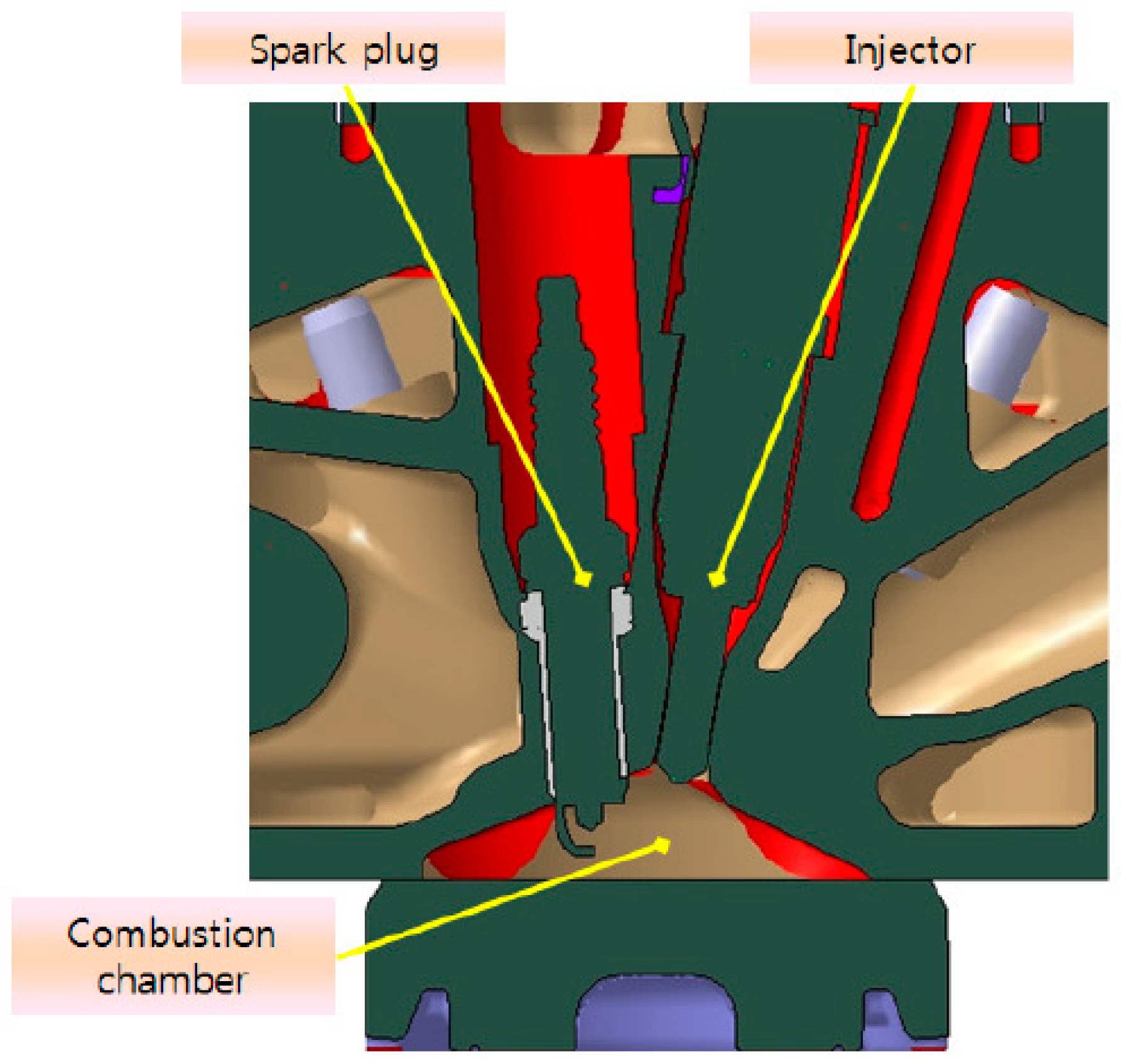
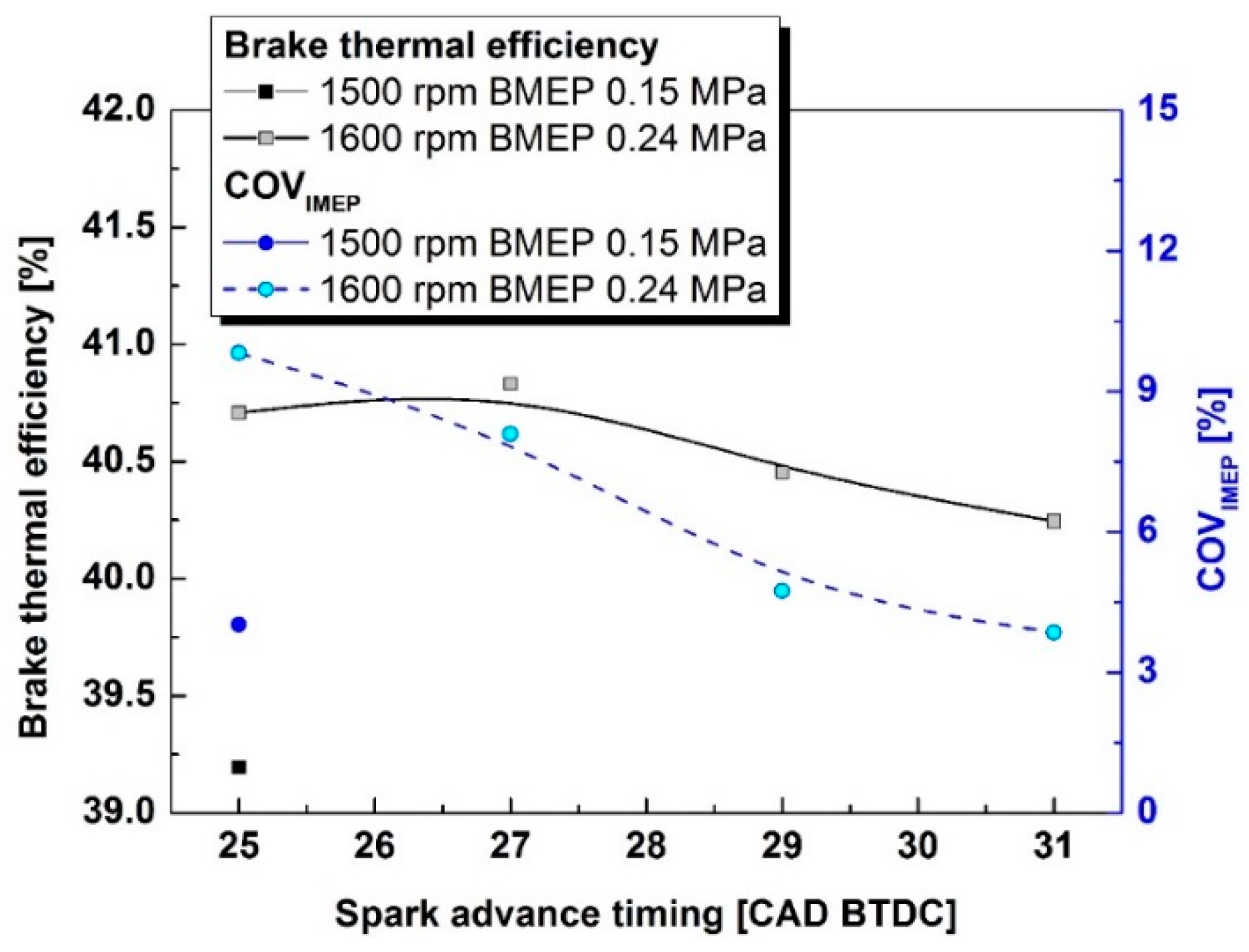
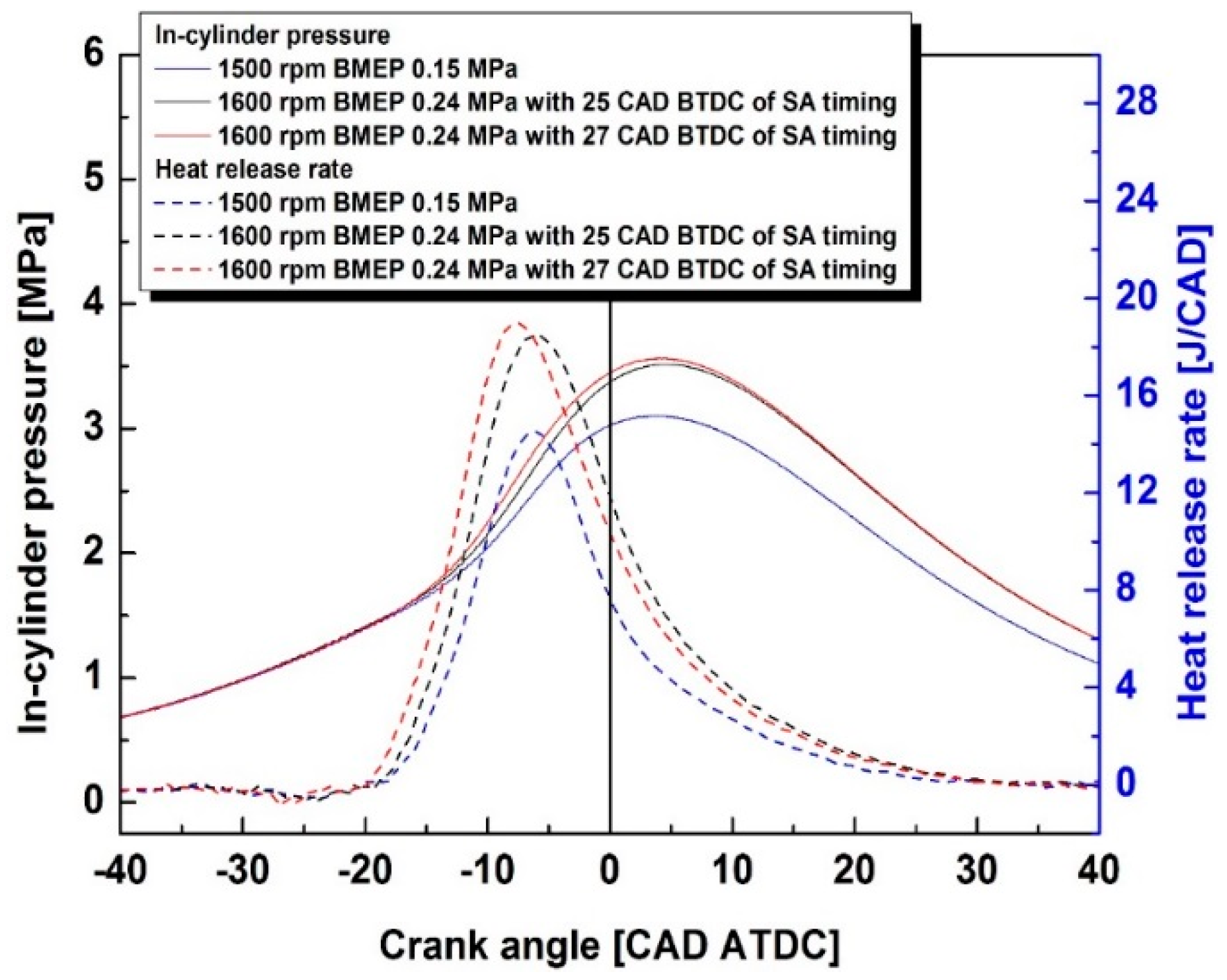
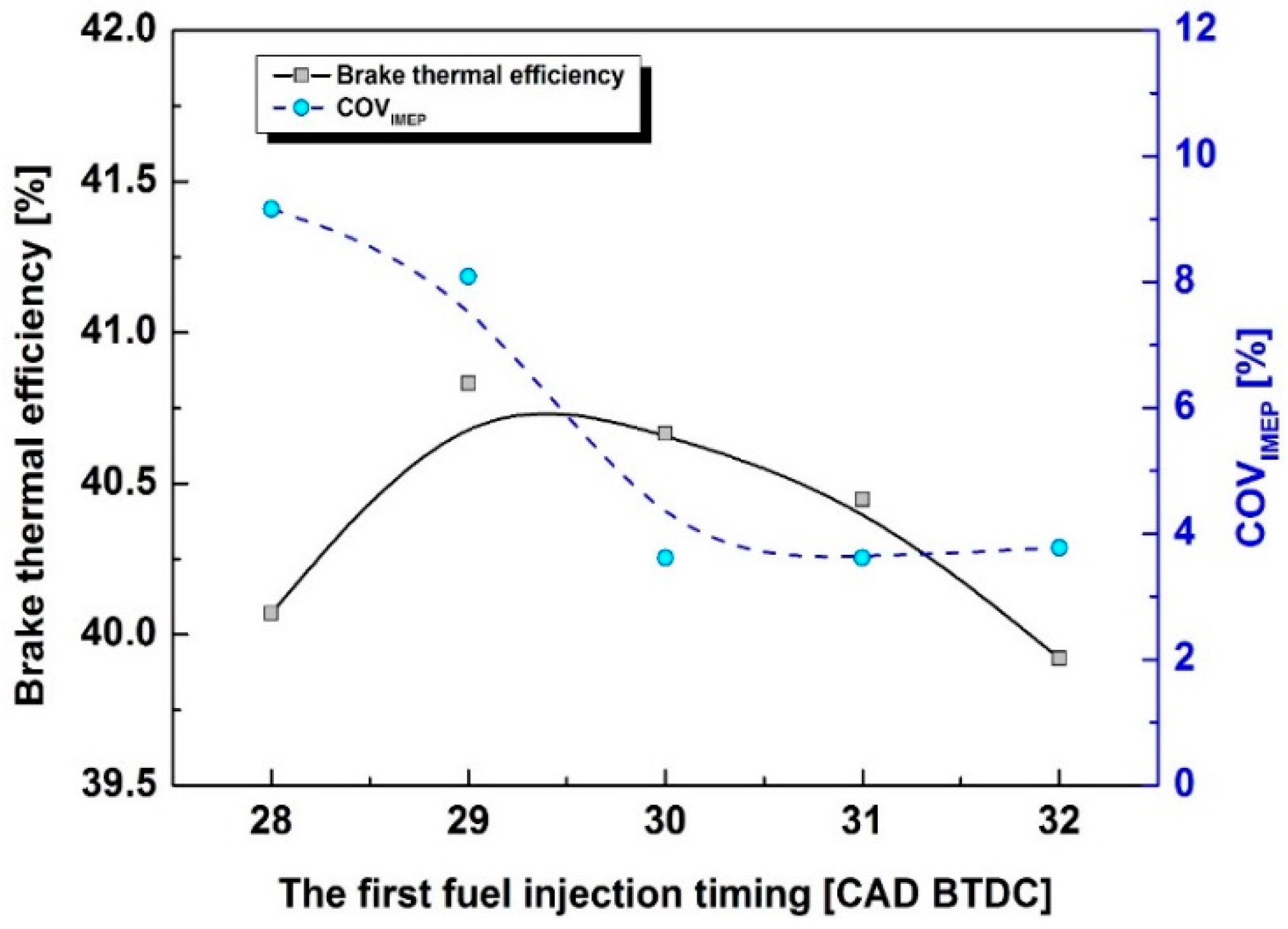
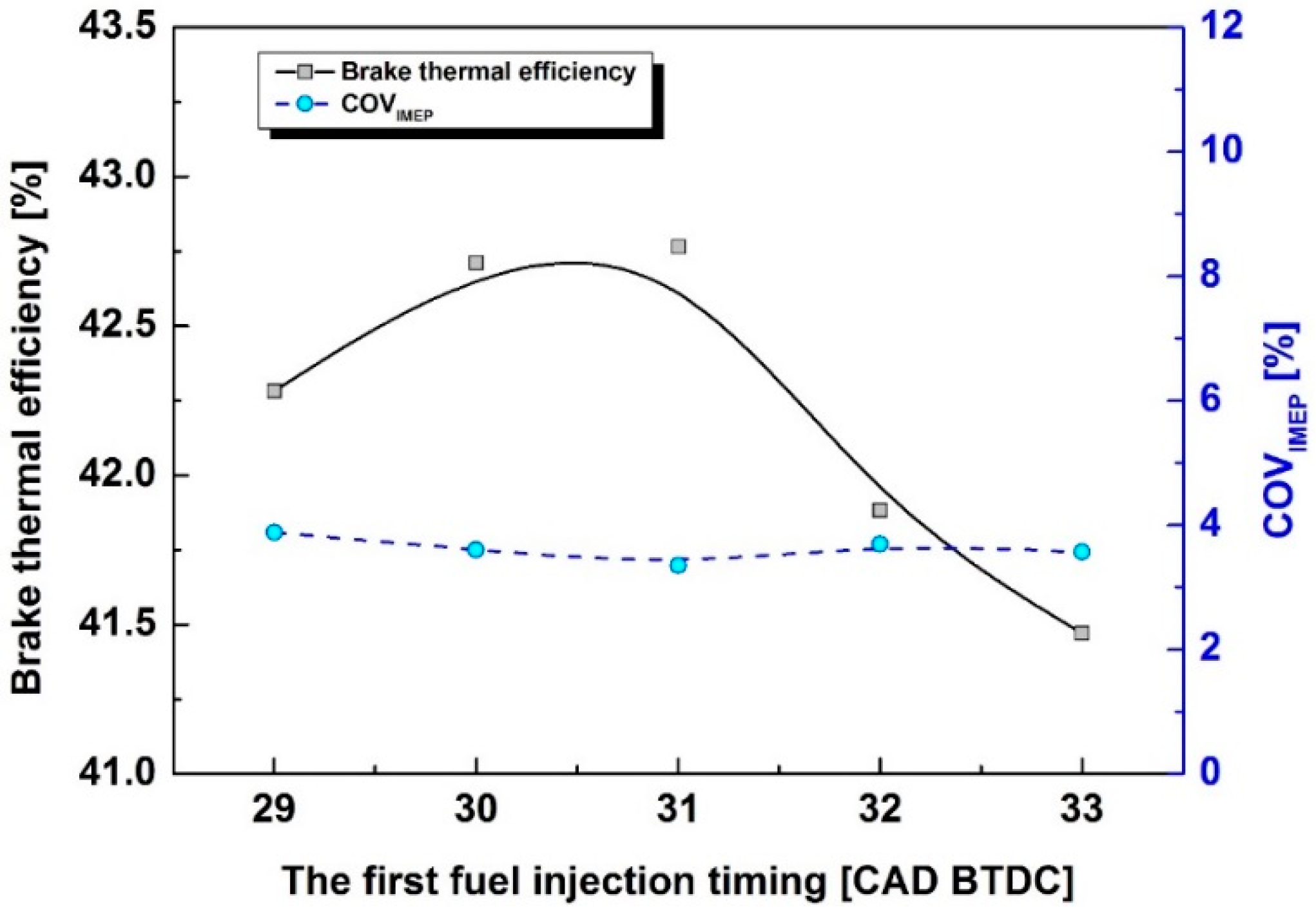
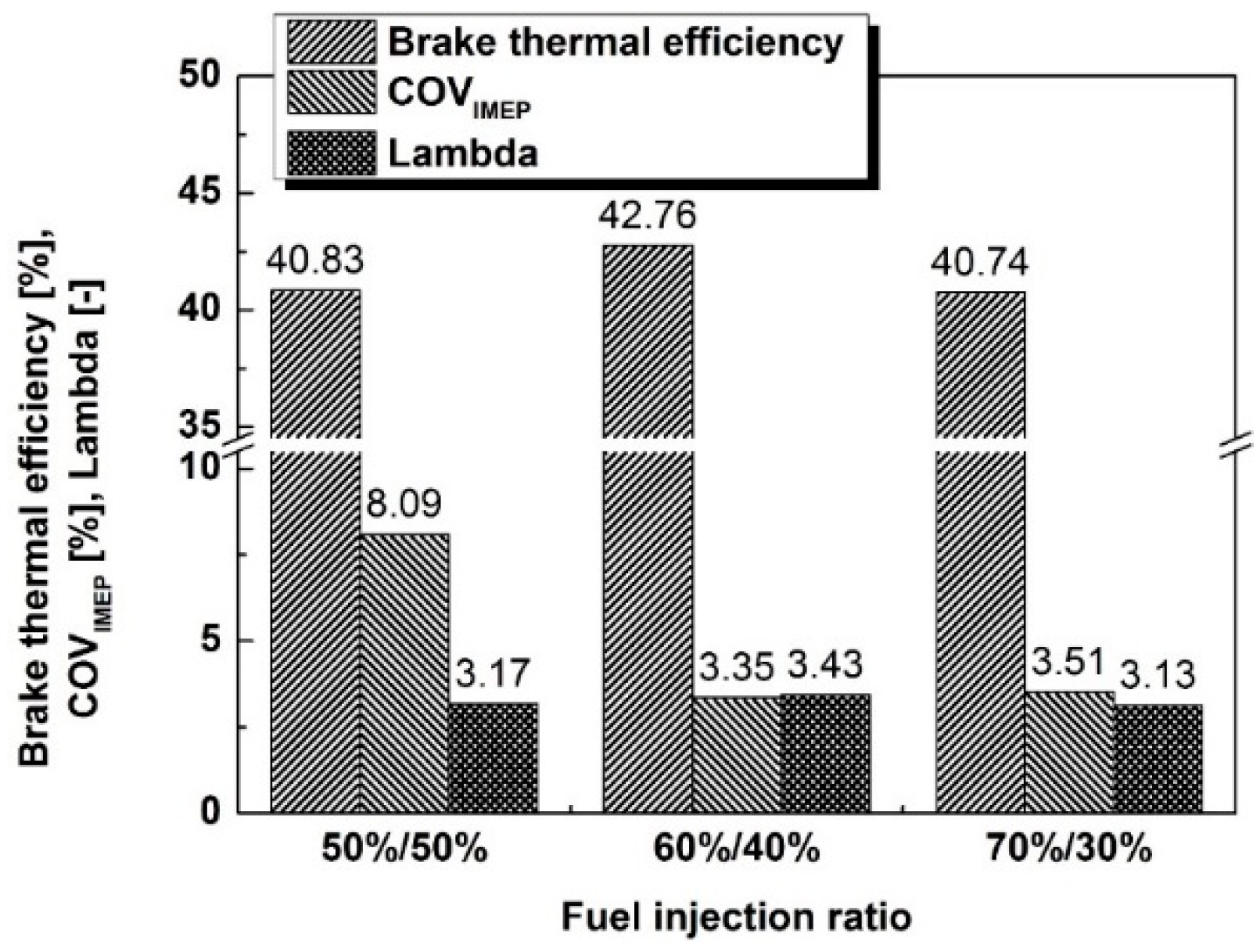
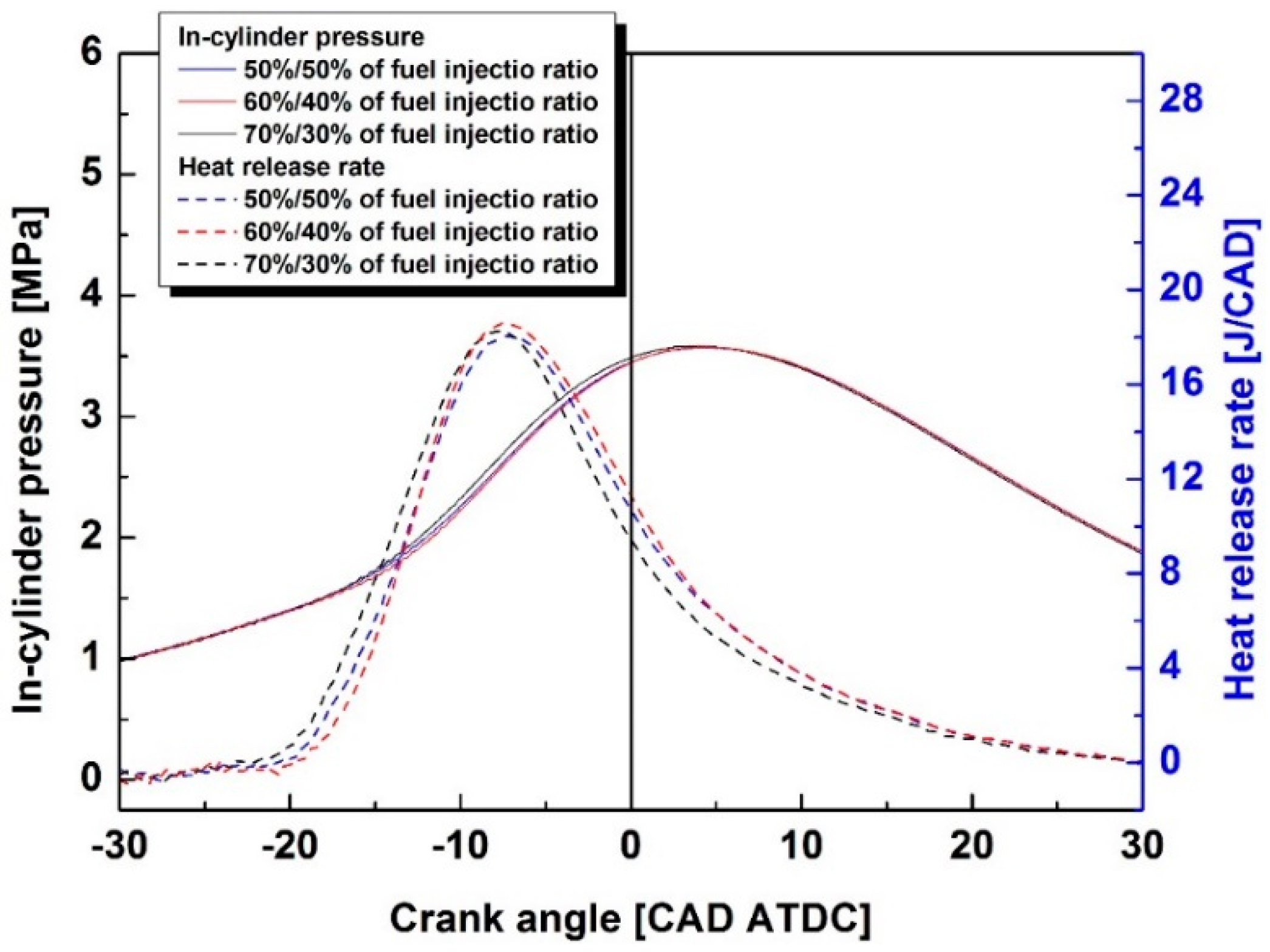
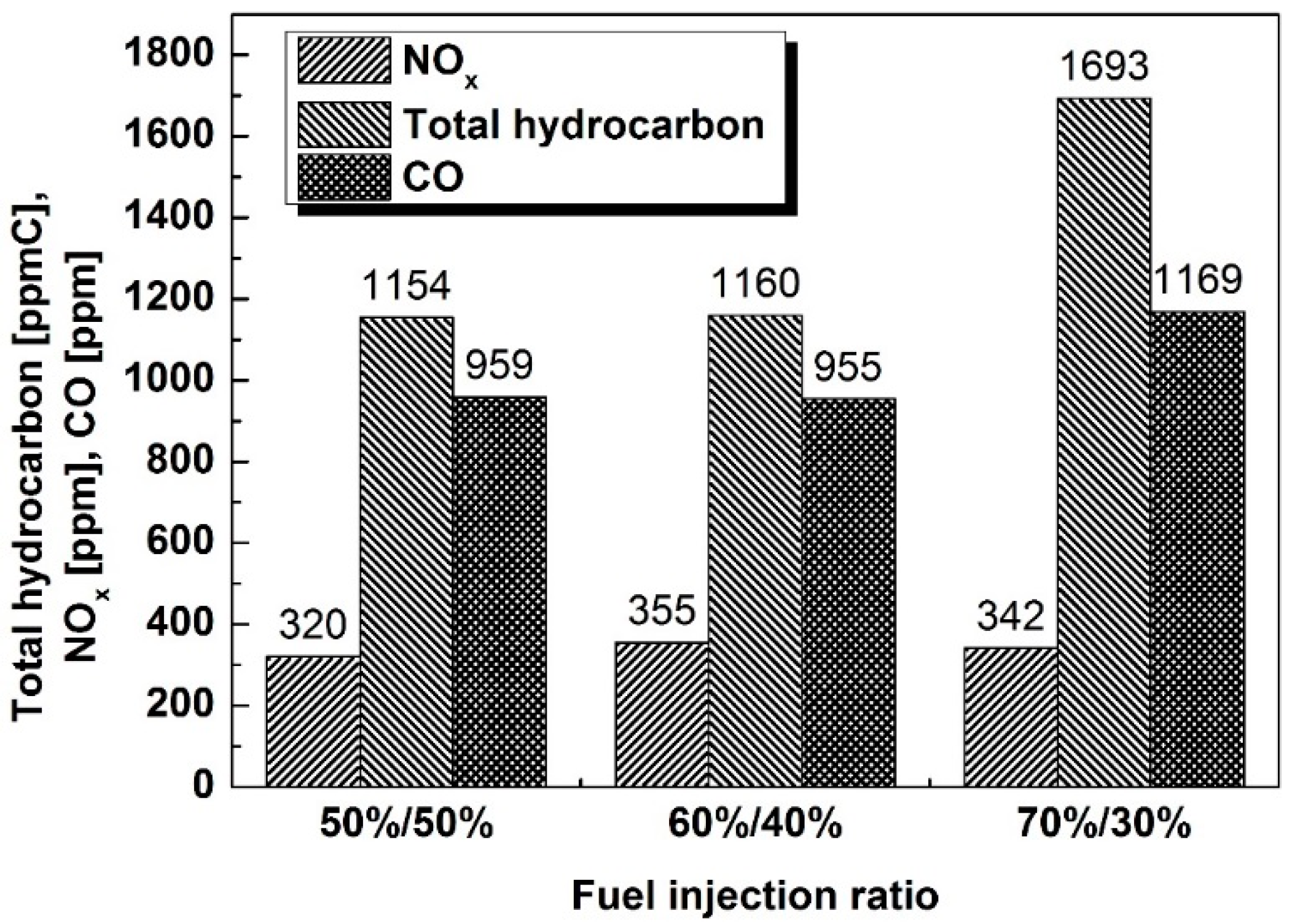
| Parameter | Specifications |
|---|---|
| Displaced volume | 1988 cc |
| Stroke | 86 mm |
| Bore | 86 mm |
| Connecting rod | 255 mm |
| Compression ratio | 10:1 |
| Number of valves | 4 |
| Exhaust valve timing | BBDC 7 CAD/ATDC 67 CAD 1 |
| Intake valve timing | BTDC 48 CAD/ABDC 0 CAD 2 |
| Operating Point (Speed and Load a) | Fuel Injection Ratio | First Fuel Injection Timing | Spark Advance Timing | Second Fuel Injection Timing |
|---|---|---|---|---|
| 1500 rpm 0.15 MPa | 50%/50% | 27 CAD BTDC | 25 CAD BTDC | 20 CAD BTDC |
| 1600 rpm 0.24 MPa | 50%/50% | 28–33 CAD BTDC | 25–31 CAD BTDC | 20–26 CAD BTDC |
| 60%/40% | 23–33 CAD BTDC | 21–27 CAD BTDC | 17–21 CAD BTDC | |
| 70%/30% | 32 CAD BTDC | 27 CAD BTDC | 23 CAD BTDC |
© 2016 by the authors; licensee MDPI, Basel, Switzerland. This article is an open access article distributed under the terms and conditions of the Creative Commons Attribution (CC-BY) license (http://creativecommons.org/licenses/by/4.0/).
Share and Cite
Park, C.; Kim, T.; Cho, G.; Lee, J. Combustion and Emission Characteristics According to the Fuel Injection Ratio of an Ultra-Lean LPG Direct Injection Engine. Energies 2016, 9, 920. https://doi.org/10.3390/en9110920
Park C, Kim T, Cho G, Lee J. Combustion and Emission Characteristics According to the Fuel Injection Ratio of an Ultra-Lean LPG Direct Injection Engine. Energies. 2016; 9(11):920. https://doi.org/10.3390/en9110920
Chicago/Turabian StylePark, Cheolwoong, Taeyoung Kim, Gyubaek Cho, and Janghee Lee. 2016. "Combustion and Emission Characteristics According to the Fuel Injection Ratio of an Ultra-Lean LPG Direct Injection Engine" Energies 9, no. 11: 920. https://doi.org/10.3390/en9110920
APA StylePark, C., Kim, T., Cho, G., & Lee, J. (2016). Combustion and Emission Characteristics According to the Fuel Injection Ratio of an Ultra-Lean LPG Direct Injection Engine. Energies, 9(11), 920. https://doi.org/10.3390/en9110920





